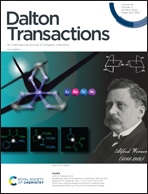Rendering classical hydrophilic enantiopure Werner salts [M(en)3]n+nX− lipophilic (M/n = Cr/3, Co/3, Rh/3, Ir/3, Pt/4); new chiral hydrogen bond donor catalysts and enantioselectivities as a function of metal and charge†
Abstract
Known hydrophilic halide salts of the title compounds are converted to new lipophilic BArf− (B(3,5-C6H3(CF3)2)4−) salts. These are isolated as hydrates (Λ- or Δ-[M(en)3]n+nBArf−·zH2O; z = 17–9) and characterized by NMR (acetone-d6) and microanalyses. Thermal stabilities are probed by capillary thermolyses and TGA and DSC measurements (onset of dehydration 71–151 °C). In the presence of tertiary amines, they are effective catalysts for enantioselective Michael type carbon–carbon or carbon–nitrogen bond forming additions of 1,3-dicarbonyl compounds (acceptors: trans-β-nitrostyrene, di-tert-butylazodicarboxylate, 2-cyclopenten-1-one; average ee = 33%, 52%, 17%). Effects of the metal and charge upon enantioselectivities are analyzed. A number of properties appear to correlate to the NH Brønsted acidity order ([Pt(en)3]4+ > [Cr(en)3]3+ > [Co(en)3]3+ > [Rh(en)3]3+ > [Ir(en)3]3+).
![Graphical abstract: Rendering classical hydrophilic enantiopure Werner salts [M(en)3]n+nX− lipophilic (M/n = Cr/3, Co/3, Rh/3, Ir/3, Pt/4); new chiral hydrogen bond donor catalysts and enantioselectivities as a function of metal and charge](/en/Image/Get?imageInfo.ImageType=GA&imageInfo.ImageIdentifier.ManuscriptID=D0DT00523A&imageInfo.ImageIdentifier.Year=2020)


 Please wait while we load your content...
Please wait while we load your content...